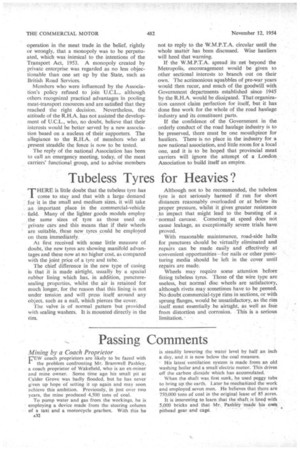Passing Comments
Page 34

Page 35

If you've noticed an error in this article please click here to report it so we can fix it.
Mining by a Coach Proprietor Mining by a Coach Proprietor
rEW coach proprietors are likely to be faced with I the problem confronting Mr. Bramwell Pashley, a coach proprietor of Wakefield, who is an ex-miner and mine owner. Some time ago his small pit at Calder Grove was badly flooded, but he has never given up hope of setting it up again and may soon achieve this ambition. Previously, in just over two years, the mine produced 4,500 tons of coal.
To pump water and gas from the workings, he is employing a device made from the steering column of a taxi and a motorcycle gearbox. With this he n.32 is steadily lowering the water level by half an inch a day, and it is now below the coal measure.
His latest ventilation system is made from an old washing boiler and a small electric motor. This drives off the carbon dioxide which has accumulated. •
When the shaft was first sunk, he used peggy tubs to bring up the earth. Later he mechanized the work and employed seven men. He believes that there are 750,000 tons of coal in the original lease of 85 acres.
It is interesting to learn that the shaft, is lined with 5,000 bricks and that Mr. Pashley -made his own' pithead gear and cage.
A Pioneer of Big Pneumatics
nPERATORS of goods and passenger vehicles have
reason to be thankful to Mr. A. S. Bishop who, as announced last week, has been appointed as the first British managing director of the Goodyear concern in Britain.
It was he who, from 1920 onwards, championed the cause of the giant pneumatic tyre in Britain, particularly in connection with its use on buses. In this campaign The Commercial Motor also took a leading part. To convince the authorities that even if such a tyre on a bus • burst, the vehicle concerned Would not overturn, nor would pedestrians in the vicinity be injured by glass, which it was thought might be broken by the `.` explosion," Mr. Bishop ran the wheels of a giant-tyred bus over a plank in which were mounted sharp steel spikes. The rapid deflation resulting was proved riot to be the cause of any such dangers. Subsequently, permission to use pneumatic tyres on London's double-deckers was accorded by the Public Carriage Department of Scotland Yard.
Tightening a Nut
AT a-recent function, Sir Miles Thomas, chairman of British Overseas Airways Corporatioh, defined a mechanic as a man who tightened a nut with a pair of pliers, and an engineer as one who did the job with a hammer andchisel •
Sir Walter Puckey, president of the Institution of Production Engineers, went one better when he spoke at that body's annual dinner. He said that a production engineer made the effort of tightening the nut unnecessary, as he forgot to mill the flats on the nut. A chemical engineer, however, had the most simple approach of all. He just let the whole thing rust solid.




































































































